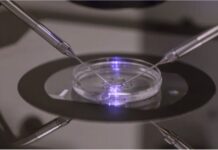Ended soon

A groundbreaking experimental procedure employing stem cell transplants to treat severe eye injuries has unveiled promising results in an early-stage study conducted in the United States. This innovative technique targets “limbal stem cell deficiency,” a corneal disorder often triggered by chemical burns and eye injuries, ultimately hindering patients from undergoing standard corneal transplants to restore their vision. The procedure revolves around the extraction of a small biopsy of healthy limbal stem cells from an unaffected eye, cultivating and expanding them within a laboratory setting, and subsequently transplanting these cells into the injured eye.
Dr. Ula Jurkunas, an accomplished ophthalmologist at Mass Eye and Ear in Boston, spearheaded this pioneering study, the first of its kind in the U.S. The initial findings, which were unveiled in the Science Advances journal, demonstrated that every participant in the study witnessed a restoration of their cornea surfaces. This auspicious advancement has kindled renewed optimism within the medical community, prompting the initiation of an extensive ongoing study to validate and broaden the scope of these outcomes.
Among the individuals benefitting from this remarkable breakthrough is Phil Durst, a 51-year-old resident of Homewood, Alabama. Durst’s journey through adversity commenced with a chemical accident in 2017 that resulted in the loss of his vision. He vividly recollects the excruciating pain and incapacitating repercussions, encompassing severe headaches and an extreme intolerance to light. However, his trajectory altered significantly after undergoing the experimental stem cell transplant procedure. From being plunged into a realm of complete blindness coupled with relentless headaches, he transitioned to regaining the capability to drive and navigate through life with enhanced comfort.
One of the most distinctive attributes of this pioneering technique lies in its utilization of the patient’s own tissue for transplantation, thereby circumventing the risk of donor tissue rejection. Furthermore, the study underscored the potential of this methodology to address a significant unmet clinical need. Present estimates postulate that approximately 1,000 individuals within the U.S. stand to potentially gain from this genre of stem cell transplant on an annual basis.
This research, aligned with two decades of prior study, illuminates a beacon of hope for individuals grappling with severe eye injuries, particularly those for whom treatment options are scarce. With the finalization of the next phase of the clinical trial, encompassing 15 patients, the medical community remains brimming with optimism concerning the transformative potential of stem cell transplants. As they envisage a revolutionized treatment landscape for severe eye injuries, the vision of restoring sight and enhancing the quality of life for countless individuals worldwide draws closer to reality.



